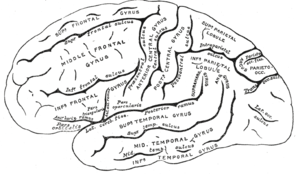Gyrus
| Gyrus | |
|---|---|
 Gyrus and sulcus | |
| Identifiers | |
| TA98 | A14.1.09.004 |
| TA2 | 5432 |
| FMA | 83874 |
| Anatomical terminology | |


In neuroanatomy, a gyrus (pl.: gyri) is a ridge on the cerebral cortex. It is generally surrounded by one or more sulci (depressions or furrows; sg.: sulcus).[1] Gyri and sulci create the folded appearance of the brain in humans and other mammals.
Structure
The gyri are part of a system of folds and ridges that create a larger surface area for the human brain and other mammalian brains.
Development
The human brain undergoes gyrification during fetal and neonatal development. In embryonic development, all mammalian brains begin as smooth structures derived from the neural tube. A cerebral cortex without surface convolutions is lissencephalic, meaning 'smooth-brained'.[4] As development continues, gyri and sulci begin to take shape on the fetal brain, with deepening indentations and ridges developing on the surface of the cortex.[5]
Clinical significance
Changes in the structure of gyri in the cerebral cortex are associated with various diseases and disorders. Pachygyria, lissencephaly, and polymicrogyria are all the results of abnormal cell migration associated with a disorganized cellular architecture, failure to form six layers of cortical neurons (a four-layer cortex is common), and functional problems.[6] The abnormal formation is commonly associated with epilepsy and mental dysfunctions.[7]
Lissencephaly (smooth brain) is a rare congenital brain malformation caused by defective neuronal migration during the 12th to 24th weeks of fetal gestation resulting in a lack of development of gyri and sulci.[9]
Notable gyri
- Superior frontal gyrus, lat. gyrus frontalis superior
- Middle frontal gyrus, lat. gyrus frontalis medius
- Inferior frontal gyrus, lat. gyrus frontalis inferior with 3 parts: pars opercularis (Brodmann area 44) pars triangularis (Brodmann area 45), and pars orbitalis (orbital part of inferior frontal gyrus)
- Superior temporal gyrus, lat. gyrus temporalis superior
- Middle temporal gyrus, lat. gyrus temporalis medius
- Inferior temporal gyrus, lat. gyrus temporalis inferior
- Fusiform gyrus, lat. gyrus occipitotemporalis lateralis
- Parahippocampal gyrus, lat. gyrus parahippocampalis
- Transverse temporal gyrus
- Lingual gyrus lat. gyrus lingualis
- Precentral gyrus, lat. gyrus praecentralis
- Postcentral gyrus, lat. gyrus postcentralis
- Supramarginal gyrus, lat. gyrus supramarginalis
- Angular gyrus, lat. gyrus angularis
- Cingulate gyruslat. gyrus cinguli
- Fornicate gyrus
